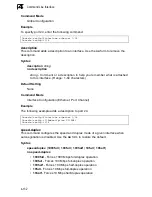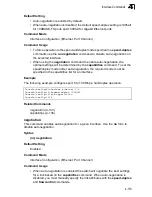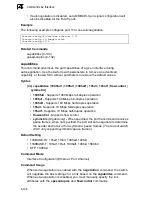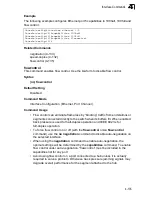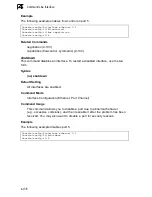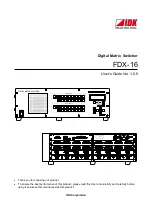
SNMP Commands
4-121
4
• SNMP Version: 1
• UDP Port: 162
Command Mode
Global Configuration
Command Usage
• If you do not enter an
snmp-server host
command, no notifications are sent.
In order to configure the switch to send SNMP notifications, you must enter at
least one
snmp-server host
command. In order to enable multiple hosts, you
must issue a separate
snmp-server host
command for each host.
• The
snmp-server host
command is used in conjunction with the
snmp-server enable traps
command. Use the
snmp-server enable traps
command to enable the sending of traps or informs and to specify which
SNMP notifications are sent globally. For a host to receive notifications, at
least one
snmp-server enable traps
command and the
snmp-server host
command for that host must be enabled.
• Some notification types cannot be controlled with the
snmp-server enable
traps
command. For example, some notification types are always enabled.
• Notifications are issued by the switch as trap messages by default. The
recipient of a trap message does not send a response to the switch. Traps are
therefore not as reliable as inform messages, which include a request for
acknowledgement of receipt. Informs can be used to ensure that critical
information is received by the host. However, note that informs consume more
system resources because they must be kept in memory until a response is
received. Informs also add to network traffic. You should consider these
effects when deciding whether to issue notifications as traps or informs.
To send an inform to a SNMPv2c host, complete these steps:
1. Enable the SNMP agent (page 4-117).
2. Allow the switch to send SNMP traps; i.e., notifications (page 4-122).
3. Specify the target host that will receive inform messages with the
snmp-server host
command as described in this section.
4. Create a view with the required notification messages (page 4-125).
5. Create a group that includes the required notify view (page 4-126).
To send an inform to a SNMPv3 host, complete these steps:
1. Enable the SNMP agent (page 4-117).
2. Allow the switch to send SNMP traps; i.e., notifications (page 4-122).
3. Specify the target host that will receive inform messages with the
snmp-server host
command as described in this section.
4. Create a view with the required notification messages (page 4-125).
5. Create a group that includes the required notify view (page 4-126).
6. Specify a remote engine ID where the user resides (page 4-123).
7. Then configure a remote user (page 4-128).
• The switch can send SNMP Version 1, 2c or 3 notifications to a host IP
address, depending on the SNMP version that the management station
Summary of Contents for 24/48 10/100 Ports + 2GE
Page 2: ......
Page 4: ...ES3526XA ES3552XA F2 2 6 3 E122006 CS R02 149100005500H...
Page 18: ...Contents xiv...
Page 22: ...Tables xviii...
Page 26: ...Figures xxii...
Page 34: ...Introduction 1 8 1...
Page 44: ...Initial Configuration 2 10 2...
Page 242: ...Configuring the Switch 3 198 3...
Page 498: ...Software Specifications A 4 A...
Page 511: ......
Page 512: ...ES3526XA ES3552XA E122006 CS R02D 149100005500H...


























